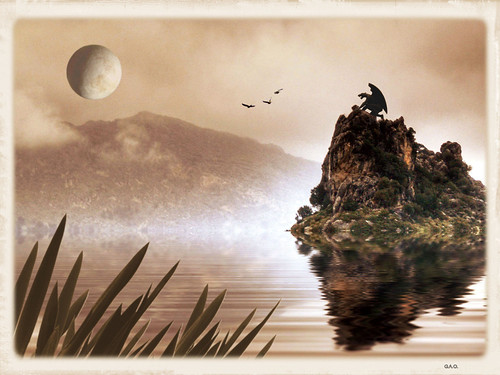"HIC IACET SEPULTUS INCLITUS REX ARTURIUS IN INSULA AVALONIA"
"Here lies buried the renowned King Arthur in the Isle of Avalon"
According to Geoffrey and much subsequent literature, Avalon is the place where King Arthur was taken after fighting Mordred at the Battle of Camlann. Welsh and Breton tradition claimed that Arthur had never really died, but would inexorably return to lead his people against their enemies, but some later writers were less credulous, and said that Arthur had in fact died there. Geoffrey dealt with Avalon again in his Vita Merlini, in which he describes the character Morgan le Fay as the chief of nine sisters who live on Avalon. Morgan remained associated with the island in later literature, as does Arthur's mentor, the Lady of the Lake.
By the 12th century Avalon became associated with Glastonbury, when monks at Glastonbury Abbey claimed to have discovered the bones of Arthur and his queen. Though no longer an island at the time, the high conical bulk of Glastonbury Tor had been surrounded by marsh before the surrounding fenland in the Somerset Levels was drained. According to later chroniclers, notably Giraldus Cambrensis, during King Henry II's reign the abbot of Glastonbury, Henry of Blois, commissioned a search of the abbey grounds. At a depth of 5 m (16 feet) the monks discovered a massive oak coffin and an iron cross bearing the description: Hic jacet sepultus inclitus rex Arthurus in insula Avalonia. ("Here lies renowned King Arthur in the island of Avalon"). Inside the coffin were two bodies, who Giraldus refers to as Arthur and "his queen". In 1278 the remains were reburied with great ceremony, attended by King Edward I and his queen, before the High Altar at Glastonbury Abbey, where they were the focus of pilgrimages until the Reformation. However, historians generally dismiss the authenticity of the find, attributing it to a publicity stunt performed to raise funds to repair the Abbey, which was mostly burned down in 1184.
Other theories point to l'Île d'Aval or Daval, on the coast of Brittany, and Burgh by Sands, in Cumberland, which was in Roman times the fort of Aballava on Hadrian's Wall, and near Camboglanna, upwards on the Eden, now Castlesteads. Coincidentally, the last battle site of Arthur's campaigns is said to have been named Camlann. Other candidates include the Bourgogne town of Avallon, suggested by Geoffrey Ashe and Bardsey Island in Gwynedd, famous for its apples and also connected with Merlin. Others have claimed the most likely location to be St Michael's Mount in Cornwall, which is near to other locations associated with the Arthurian legends. St Michael's Mount is an island which can be reached by a causeway at low tide. The matter is confused somewhat by similar legends and place names in Britanny.
Possible assumption by Geoffrey that Pytheas' Abalus was near Britain: The ancient Greek traveller Pytheas, who travelled to Britain around 320BC and then to an island called "Thule", considered today to have been Iceland, also went to where amber was collected; and he wrote the island was called Abalus or Abalum. While it is likely from evidence beyond the scope of this discussion, that Pytheas visited the southeast Baltic region which was the main source of trade amber and that the "island" was actually the Samland Peninsula which is filled with amber still, it is possible that Geoffrey - whose work was very inventive and creative to say the least - read the Latin texts about Pytheas travels, and arbitrarily assumed Abalus was near Britain, like Thule and felt compelled to include it in his creative embellishments and expansions of the Arthurian myths.
http://en.wikipedia.org/wiki/Avalon














No hay comentarios:
Publicar un comentario